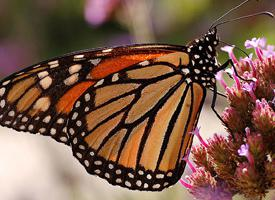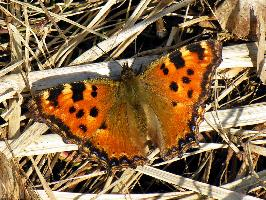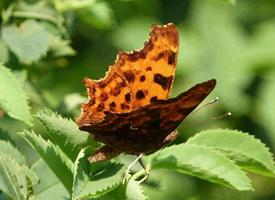
Statut de conservation
| Menacé |
Description de l'animal
The Monarch butterfly (Danaus plexippus) is a milkweed butterfly in the family Nymphalidae and is perhaps one of the most recognized and studied butterflies in the world. Its striking orange wings, laced with black lines and bordered with white dots, make it an iconic symbol of the beauty and complexity of nature. The Monarch is not only celebrated for its aesthetic appeal but also for its astonishing migratory behavior, a unique phenomenon that has intrigued scientists and nature lovers alike.Adult Monarchs boast wingspans ranging from 3.5 to 4 inches (8.9 to 10.2 cm), making them a conspicuous presence in their natural habitats. The vivid orange coloration of their wings serves as a warning to predators about their unpalatability, a defense mechanism derived from the toxic milkweed plants their larvae feed on. This relationship with milkweed is crucial, as it is the sole food source for Monarch caterpillars, making the plant's availability a critical factor in their survival.
The life cycle of the Monarch butterfly is a fascinating journey that encompasses four stages: egg, larva (caterpillar), pupa (chrysalis), and adult. The entire cycle spans approximately one month, with the female laying her eggs on the underside of milkweed leaves. These eggs hatch into caterpillars that voraciously consume milkweed leaves, growing rapidly and shedding their skin multiple times. After reaching full size, the caterpillar forms a chrysalis, within which it undergoes a remarkable transformation (metamorphosis) to emerge as a butterfly.
One of the most remarkable aspects of the Monarch butterfly is its migratory pattern. Monarchs born in the United States and Canada undertake a monumental journey of up to 3,000 miles (4,828 kilometers) to reach their wintering grounds in the oyamel fir forests of Central Mexico. This migration occurs in the fall, and the butterflies travel in massive groups, creating a breathtaking spectacle. Intriguingly, it takes multiple generations to complete the round trip, as the individuals that return north in the spring are the descendants of those that migrated south the previous fall.
The Monarch's migration is an evolutionary marvel and is critical for its survival, yet it is under threat due to habitat loss, climate change, and the decline of milkweed populations due to agricultural practices. Conservation efforts are underway to protect Monarch habitats and promote the planting of milkweed to ensure that future generations can continue to witness the incredible journey of these butterflies.
In addition to its ecological significance, the Monarch butterfly holds cultural and symbolic value for many people. It is seen as a symbol of transformation and endurance, and its migration is celebrated in festivals and educational programs across North America. The Monarch's beauty, resilience, and extraordinary lifecycle continue to captivate and inspire, making it a cherished emblem of the natural world.
Animaux similaires
Nouvelles photos d'animaux
Top 10 des animaux
- Dolphin gull (Leucophaeus scoresbii)
- Diana monkey (Cercopithecus diana)
- Moustached guenon (Cercopithecus cephus)
- Galápagos tortoise (Geochelone nigra complex)
- Russian tortoise (Testudo horsfieldii)
- Stone loach (Barbatula barbatula)
- Japanese macaque (Macaca fuscata)
- Common flying dragon (Draco volans)
- Greek tortoise (Testudo graeca)
- Vendace (Coregonus albula)


